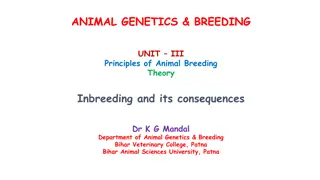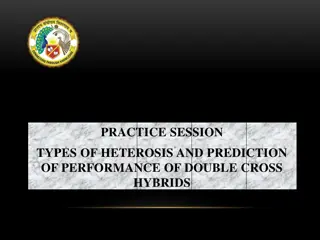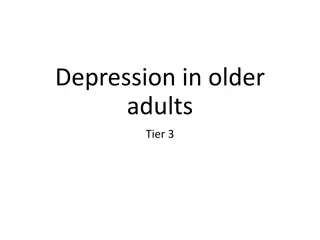Understanding Inbreeding Depression and Heterosis in Animal Genetics
Inbreeding depression is a decrease in the mean phenotypic value of traits related to fitness and physiological efficiency due to inbreeding. It involves a reduction in heterozygosity within a population, leading to an increase in homozygosity. The degree of inbreeding is quantified using the inbreeding coefficient, and it affects the frequency of genotypes in a population. Understanding these concepts is crucial in animal breeding for optimizing genetic diversity and health.
Download Presentation

Please find below an Image/Link to download the presentation.
The content on the website is provided AS IS for your information and personal use only. It may not be sold, licensed, or shared on other websites without obtaining consent from the author. Download presentation by click this link. If you encounter any issues during the download, it is possible that the publisher has removed the file from their server.
E N D
Presentation Transcript
ANIMAL GENETICS & BREEDING UNIT III Principles of Animal Breeding Theory Inbreeding Depression & Heterosis Dr K G Mandal Department of Animal Genetics & Breeding Bihar Veterinary College, Patna Bihar Animal Sciences University, Patna
Inbreeding Depression Inbreeding Depression: Decrease in mean phenotypic value of the characters associated with fitness, physiological efficiency of the individuals due to inbreeding is known as inbreeding depression. Inbreeding converts a proportion of heterozygotes into identical homozygotes in each generation. Hence, the frequency of homozygous genotype increases at the expense heterozygotes. reproduction and of frequency of
The proportionate reduction of heterozygosity in an inbred population relative to that of random mating population (base population) is the degree of inbreeding. The degree of inbreeding is expressed as inbreeding coefficient, F. Hence, degree of inbreeding, F =Ho Hi Where, Ho = proportion of heterozygous genotypes in the base population. Hi = proportion of heterozygous genotypes in the inbred population. After simplification, Hi = Ho HoF = Ho(1-F) Ho
Let us consider a locus with two alleles A1 & A2 with their respective frequencies is po and qo in the base population. Frequency of three genotypes at base population: A1A1 = po2 A1A2 = 2poqo A2A2 = qo2 Frequency of three genotypes due to inbreeding: Frequency of heterozygotes in inbred population Hi(A1A2) = Ho(1-F) = 2poqo(1-F) = 2poqo 2poqoF Thus the change in the frequency of heterozygotes due to inbreeding is - 2poqoF.
The reduction in frequency of heterozygotes due to inbreeding is balanced with the increase in frequency of homozygotes in equal amount i.e., 2poqoF. The frequency of homozygous dominants, A1A1 = po2 + poqoF and frequency of recessives, A2A2 = qo2 + poqoF
Table 1. Genotype frequencies for a given locus with two alleles in an inbred population. Genotype Frequency in base population (F = 0) Genotype Frequency due to inbreeding Frequency due to complete inbreeding (F=1) po 0 qo A1A1 A1A2 A2A2 po2 2poqo qo2 Po2 + poqoF 2poqo 2poqoF qo2 + poqoF
Change of population mean due to inbreeding: Suppose Mo = population mean in the base population. = a(p0 q0) + 2p0q0d MF = population mean due to inbreeding Genotype Genotype frequency due to inbreeding Genotypic value Frequency x Genotypic value A1A1 A1A2 Po2 + poqoF 2poqo 2poqoF qo2 + poqoF a d a(Po2 + poqoF) d(2poqo 2poqoF) -a(qo2 + poqoF) A2A2 -a
The population mean due to inbreeding, MF = a(Po2 + poqoF) + d(2poqo 2poqoF) -a(qo2 + poqoF) After simplification, = a(po qo) + 2poqod 2poqodF = MO - 2poqodF MF = M0 2pqdF In case of polygenic traits when a large number of loci are involved, then population mean due to inbreeding, = M0 2F pqd
Conclusion: i) There is reduction in mean phenotypic value of the population due to inbreeding which is equal to the amount -2F pqd. i) Reduction in mean phenotypic value is the function of gene frequencies, degree of dominance and the amount of inbreeding coefficient. ii) The inbreeding depression intermediate gene frequencies i.e., when p = q = 0.5. iii) Reduction in mean phenotypic value is the linear function of inbreeding coefficient, F. iv) Change in population mean under inbreeding depends upon the type of gene action. will be maximum at
(a) There will be no change of mean value under inbreeding if there is no dominance i.e. when d = 0. In case of polygenic traits, the dominance is not sufficient cause to reduce the mean value but it is the directional dominance. (b) No change in mean value due to inbreeding is also an indication of the additive gene action. (c) The change in reduction of mean phenotypic value will be more if the character is under the control of over dominance kind of gene action. As long as d is positive, the inbreeding will produce a decline in mean value of inbred population.
Heterosis Heterosis: The average superiority of outbreds / crossbred progeny over their mid-parental value (parental average) is termed as heterosis or hybrid vigour. Heterosis is complementary to inbreeding depression. When two different breeds or lines are crossed, their progeny shows an increase of those characters that previously suffered a reduction from inbreeding. In general terms, the fitness lost on inbreeding tends to be restored on crossing. The amount of heterosis is the difference between means of crossbreds and inbred.
Heterosis is expressed in terms of percentage (%). ?? ?? ? 100% ?? Heterosis (%) = Where, XO and XP are the average performance of offspring and mid-parental value respectively. Example: Suppose the average litter size of pig at weaning is 7.0 for breed A and 8.0 for breed B. The average litter size of their F1 (half-bred) is 8.5. The heterosis (%) would be [(8.5 7.5)x100] / 7.5 = (1x100)/7.5 = 13.33%.
Heterosis in terms of gene frequency: The theoretical basis of heterosis is better expressed in terms of gene frequencies of two lines involved in crossing. Let us consider two random bred populations as the parent population. The parent populations are crossed to produce F1, and then the F1 progenies are mated inter-se to produce F2 generation. The amount of heterosis shown by the F1 or the F2 will be measured as the deviation from the mid- parent value i.e., the difference from the mean of the two parent populations.
Let us consider the effect of a single locus with alleles A1 & A2 with their respective frequency as p and q in one population and p and q in another population. Let the difference of gene frequency between the two populations be y , so that y = p p = q q. Therefore, p = (p y) and q = (q + y) Let us first deduce the population mean of two parent populations and their mid-parent value, then the mean of F1 and F2.
Mean of two parent populations, MP1 and MP2, may be obtained in the following way: Genotype A1A1 A1A2 A2A2 Genotypic values a P2 ap2 d -a q2 -aq2 Genotypic freq. GVxGF 2pq 2pqd MP1 = a(p q) + 2pqd as before. MP2 = a(p q ) + 2p q d (1) By putting the value of p and q in term of y & by simplification MP2 = a(p-q-2y) + 2d[pq + y(p-q) y2] .. (2)
The mid-parent value, MP = (MP1 + MP2) = [a(p - q) + 2pqd + a(p q - 2y) + 2d{pq + y(p -q) y2}] After simplification, MP = a(p q - y) + d[2pq + y(p - q) y2] (3) Mating of two populations (P1 & P2) i.e., union of their gametes to produce F1 progeny in the following way: Gametes from P1 & their frequency A1 p A1 (p-y) p(p-y) A2 (q+y) p(q+y) A2 q Gametes from P2 & their frequency q(p-y) q(q+y)
Table 3. Genotypes of F1 progeny Genotypes A1A1 A1A2 A2A2 Genotypic Frequency p(p - y) 2pq + y(p - q) q(q + y) Genotypic value a d - a The mean genotypic value of F1, MF1 = ap(p - y) + d[2pq + y(p - q)] - aq(q + y) After simplification, MF1 = a(p q y) + d[2pq + y(p - q)] (4)
The amount of heterosis, as the difference between F1 and mid-parent values, is obtained by subtracting the equation (3) from equation no. (4) : HF1 = MF1 MP = [a(p q y) + d{2pq + y(p - q)}] [a(p q - y) + d{2pq + y(p - q) y2}] = [a(p q y) + d{2pq + y(p - q)}] - a(p q - y) - d{2pq + y(p - q) y2} After simplification, = dy2 .. (5)
Since, economic traits are influenced by many pairs of gene loci, therefore, heterosis in F1, HF1 = dy2 Where, d = degree of dominance and y is the difference of gene frequencies population involved in crossing. To estimate heterosis in F2 generation, the progeny of F1 generation are to be raised to the sexual maturity and they will produce the progeny. The heterosis in F2 generation, HF2= dy2 = HF1 between two
CONCLUSION : 1. Heterosis, just like inbreeding depression, depends for its occurrence on dominance. Loci without dominance (d = 0) cause neither inbreeding depression nor heterosis. 2. The occurrence of heterosis, like inbreeding depression, depends on directional dominance. The absence of dominance is not sufficient ground for concluding that the individual loci show no dominance. 3. The amount of heterosis, following a cross between two lines/breeds/populations, depends on square of the difference of gene frequency (y) between the two populations / breeds.
4. If the lines are highly inbred and so completely homozygous for all the loci, then the difference of gene frequency between them can be either 0 or 1. Then, heterosis will be equal to the sum of the dominance deviations d ( d) of those loci. 5. The heterosis in F2 generation is reduced to half to that of heterosis exhibited in F1. In other words, the F2 is expected to drop back half-way from the F1 value towards the mid-parent value.
Genetic Basis of Heterosis: There are various thesis explaining the genetic basis of heterosis. The following are some of them: i) Theory of dominance given by Jones (1917-18). ii) Theory of heterozygosity given by Stubb Pirschle (1940). iii) Theory of non-allelic gene interaction (epistasis) as given by Oliver and Green (1944). iv) Theory of over dominance introduced by Hull (1945). Over dominance is the condition when heterozygote offspring become superior than both the homozygote parents. Out of all these theorem, the over dominance as proposed by Hull (1945) is most appropriate.
Types of Heterosis: According to the direction, heterosis is of three types : 1. Positive, 2. Negative and 3. Zero According to degree or intensity, it is of two types: 1. Euheterosis: In euheterosis the degree or intensity of heterosis is more. The traits which show greatest inbreeding depression due to inbreeding will show maximum hybrid vigour or heterosis. Lowly heritable traits like all reproductive traits, physiological efficiency and fitness etc. will show euheterosis. 2. Luxurient heterosis: In this the degree or intensity is lesser in comparison to euheterosis. Highly heritable traits like adult body weight, growth rate, etc. will show luxuriant heterosis.























